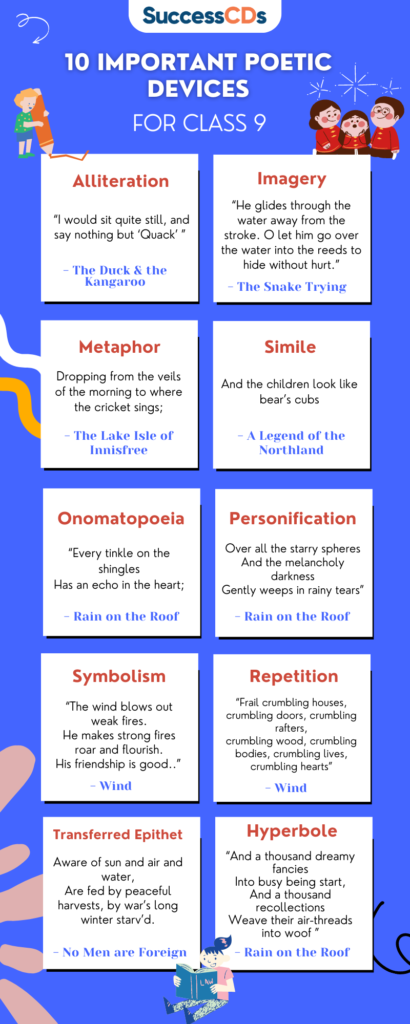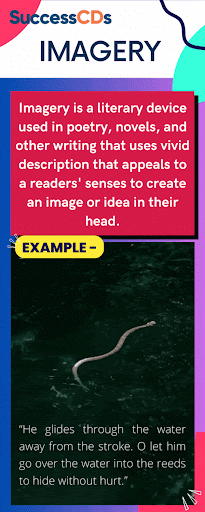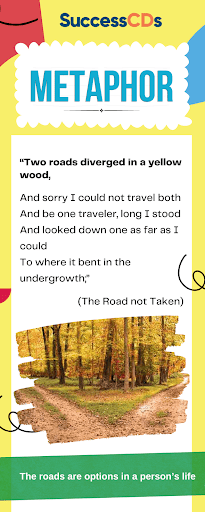Poetic Devices with examples for Class 9 English Poems
Poetic devices are very important in poetry and you may get a question in the exam, to find out the poetic device used in a particular poem. Let us end the confusion and understand the most important figures of speech for class 9 poems.
Firstly, let us know what exactly poetic devices are.
What are Poetic Devices?
A “poetic device“, commonly known as figure of speech, refers to such words or phrases that a poet uses to enhance the literal meaning of the poem, including sounds, forms, rhythms, phrases, and words. Most of the poems are created with the help of these poetic devices along with other structural, grammatical, rhythmic, metrical, verbal, and visual elements.
The poetic devices often lend the poetry a genuine feeling of beauty when incorporated in an interesting way. The greatest way to express the hidden messages in the poetry is through the employment of these tactics, which often leave the reader feeling utterly mesmerised.
Let’s have a look at some of the most commonly used poetic devices in class 9 poems.

1 Alliteration – the repetition of a consonant sound or letter at the beginning of multiple words in a series.
Example – “ I would sit quite still, and say nothing but ‘Quack’ ”
(The Duck and the Kangaroo by Edward Lear)
2 Enjambment – the continuation of a sentence beyond a line break, couplet, or stanza without an expected pause. The sentences continue to the next line without a break.
Example –
“Remember, no men are strange, no countries foreign
Beneath all uniforms, a single body breathes
(No men are Foreign by James Kirkup)
3 Imagery – a literary device used in poetry, novels, and other writing that uses vivid description that appeals to a readers’ senses to create an image or idea in their head.
Example-
“ He glides through the water away
from the stroke. O let him go
over the water
into the reeds to hide
without hurt.”
(The Snake Trying by W.W.E. Ross)

4 Metaphor – A metaphor is when a writer compares any quality of one thing to that of another.
Example-
Dropping from the veils of the morning to where the cricket sings;
It is a metaphor for the clouds in the morning sky or maybe the fog of the early morning or mist, or maybe even the dew on the morning grass. These could all appear like veils that are lifted once the sun rises.
(The Lake Isle of Innisfree by William Butler Yeats)
5 Simile – The simile, like the metaphor, offers another device for comparison. However, a simile is much more blatant and uses “like” or “as” to draw the comparison.
Example-
And the children look like bear’s cubs
(A Legend of the Northland by Phoebe Cary)
And rolled and rolled it flat;
And baked it thin as a wafer —
(A Legend of the Northland by Phoebe Cary)
6 Onomatopoeia – Onomatopoeia is a literary and poetic device wherein words are employed to imitate sounds associated with what they describe.
Example-
“ Every tinkle on the shingles
Has an echo in the heart;
( Rain on the Roof by Coates Kinney )

7 Personification – when an inanimate object, animal or idea is given human characteristics.
Example-
“ Not so much pain will do it.
The bleeding bark will heal
And from close to the ground
Will rise curled green twigs”
(On Killing a Tree by Gieve Patel)
Over all the starry spheres
And the melancholy darkness
Gently weeps in rainy tears”
(Rain on the Roof by Coates Kinney)
8 Symbolism – Poets use symbolism to convey hidden meanings. Places, objects, and actions can all be symbols, with many layers of meaning tied to them. Symbolism adds depth to the literal meaning of the poem.
Example –
“ The wind blows out weak fires.
He makes strong fires roar and flourish.
His friendship is good..”
( Wind by Subramania Bharati )
Here, the poet has used the word ‘wind’ as a symbol of the challenges that we face in our lives.
- ‘weak fires’ has been used as a symbol of people with weak will power.
- ‘strong fires’ has been used as a symbol of people with strong will power.
9 Anaphora – the repetition of words or phrases at start of consecutive poetic lines.
Example-
“Don’t break the shutters of the windows.
Don’t scatter the papers.
Don’t throw down the books on the shelf.”
(Wind by Subramania Bharati)
“ And to keep out the cold I’ve bought a cloak,
And every day a cigar I’ll smoke,
All to follow my own dear true
Love of a Kangaroo!”
(The Duck and the Kangaroo by Edward Lear)
10 Repetition – the use of the same word or phrase multiple times throughout the poem.
Example-
“ Frail crumbling houses, crumbling doors, crumbling rafters,
crumbling wood, crumbling bodies, crumbling lives,
crumbling hearts”
(Wind by Subramania Bharati)
11 Transferred Epithet – The term ‘epithet’ refers to an adjective or a phrase that modifies a noun in the sentence, most probably the subject.Thus, a transferred epithet, as the name suggests, is a poetic device formed by the transfer of an epithet.
Transferred Epithet refers to the use of an adjective or a phrase that describes a noun to modify another noun in the sentence.
Example-
“ Aware of sun and air and water,
Are fed by peaceful harvests, by war’s long winter starv’d.
Their hands are ours, and in their lines we read
A labour not different from our own.”
( No Men are Foreign by James Kirkup)
Here the harvests are not peaceful but the peasants cultivating them are in peaceful times.
12 Hyperbole – an intentionally exaggerated description, comparison, or exclamation meant to make a specific impact on a reader.
Example-
“ And a thousand dreamy fancies
Into busy being start,
And a thousand recollections
Weave their air-threads into woof ”
( Rain on the Roof by Coates Kinney )
Also See :
- Poetic Devices, Literary Devices in Poems, Examples, explanation
- Poetic Devices in Class 9 English Communicative Poems
- Poetic Devices in Class 10 English Communicative Poems
- 10 Important Poetic Devices for Class 10 with Examples
- 10 Poetic Devices with Examples for Class 11 Poems
- Important Poetic Devices for Class 12
- NCERT Class 9 English Summary, Explanation, Question Answers
- Class 9 English Literature Reader (Communicative) Lesson Explanation, Summary
- CBSE Class 9 English Poems – Summary, Explanation, Literary Devices
- CBSE Class 9 English Poems from Beehive Book – Summary, Explanation, Word Meanings
- Class 9 English MCQ Question Answers – Practice now
- Class 9 English Poems Important Questions Answers
- Class 9 English Beehive Book word meaning Prose
- Class 9 English Beehive Book Poem difficult words meaning
- CBSE Class 9 English Moments Word Meaning of All Chapter